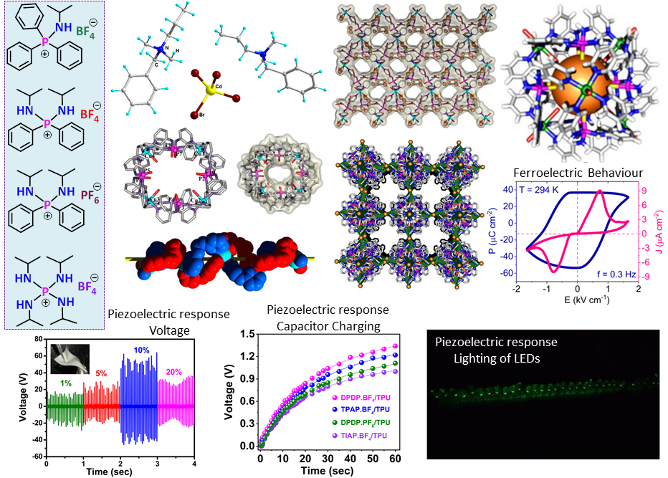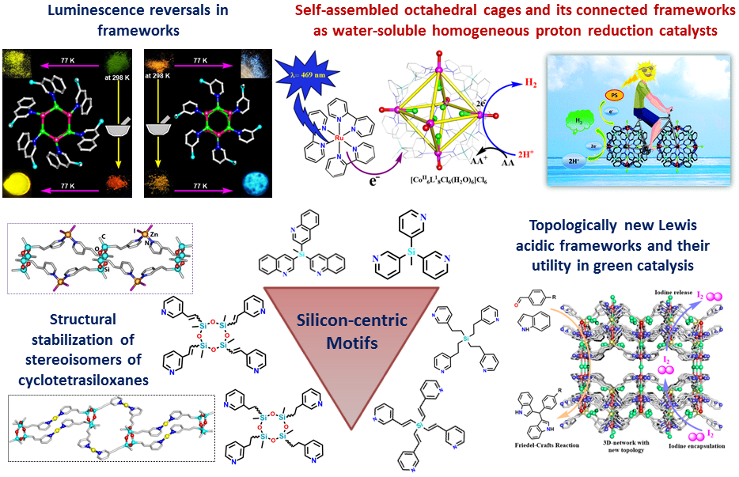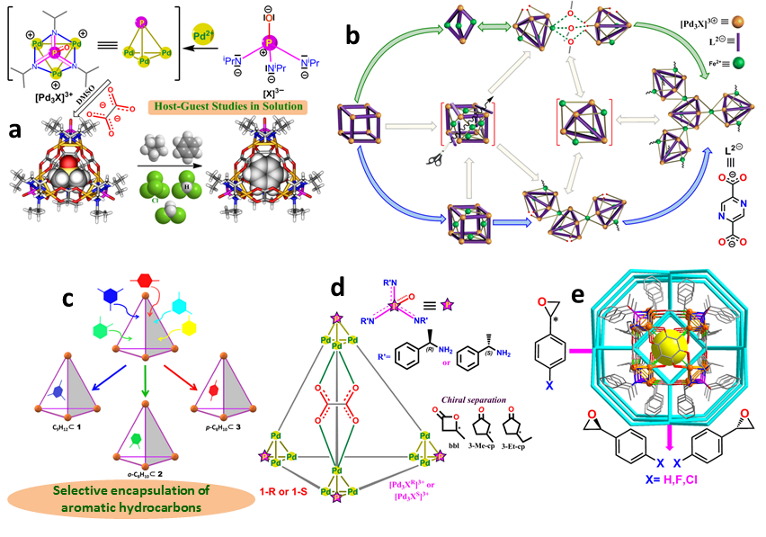


|
The research interests of our group lies in the chemistry of main group elements mostly phosphorus and silicon and their applications in the domain of supramolecular and materials chemistry. The focus areas of our research activities spans over the following major topics.
1. Organic, hybrid organic-inorganic and metal-organic ferro, piezo and pyroelectric materials. Utility of these compounds in energy applications such as nanogenerators and electronic applications such as FE-FETs. 2. Polyhedral Pd(II) based cages supported by tris(imido)phosphate trianions and their applications in host-guest chemistry and chiral separations 3. Multi-functional framework solids derived from silane and cyclic-siloxane scaffolds |
|
| Home | Research Interests | Publications | Group | Teaching | |
|
Organic, hybrid organic-inorganic and metal-organic ferro, piezo and pyroelectric materials and their energy and electronic applications
Currently, ferroelectric behaviour in organic and hybrid organic-inorganic materials are widely examined due to their simple synthesis, solvent processability, flexibility, lightness, non-toxicity and amenability to low-temperature fabrication techniques. In the first approach, we were interested in the design of a family of non-centrosymmetric charge-separated metal-ligand assemblies by utilizing lower-symmetric pyridyl functionalized phosphorus-nitrogen scaffolds. In another approach, we are interested in the salts of phosphonium and ammonium cations for halo, oxo and halogenometallate derived anions as simple ferroelectric materials and use them for the fabrication of mechanical energy harvesters. Currently, we are interested in the utility of these materials in electronic applications. |
|
R. Boomi Shankar Professor |
|
Research Interests |

|
Laboratory of Synthetic Inorganic and Materials Chemistry |
|
Polyhedral Pd(II) based cages supported by tris(imido)phosphate trianions and their applications in host-guest chemistry and chiral separations
In an effort to obtain the transition metal complexes of these polyimido anions, our group has developed novel protocols which utilize salts of certain soft metal ions as weak bases towards their deprotonation. During these reactions, a facile route to access the tris(imido)phosphate trianons, [PO(NR)3]3 ̶ , (denoted as (X)3 ̶ , in polar and protic medium was developed by employing the corresponding tris(amido)phosphates, [PO(NHR)3]3 ̶, in reaction with Pd(OAc)2. These imido anions were stabilized as tri- or hexanuclear Pd(II) complexes, in which the trianion was coordinated to the trinuclear Pd(II) centre in a cisoidal fashion. These Pd-imido complexes can further react with a wide-angle chelating ligand such as oxalic acid giving rise to an interesting charge neutral tetrahedral cage of formula {[Pd3(X)]4(C2O4)6} (Figure 3a). By employing various linkers we were able to obtain a family of neutral cages in tetrahedral, cubic, trigonal bipyramidal topologies and with larger sizes and intrinsic voids (Figure 3b). Remarkably, by utilizing chiral imido-trianions we were able to prepare chiral tetrahedral cages which show the enantiomeric separation of small racemic guest molecules. |

|
Multi-functional framework solids derived from silane and cyclic-siloxane scaffolds
Spurred by our success with tetrahedral amido- and imido-P(V) ligand platforms, we explored the utility of similar silicon centric motifs and prepared novel examples of pyridyl functionalized silane and siloxane ligands. Use of a main-group element such as Si or P as the central atom helps in obtaining identical ligand topologies for various donor functionalities and subsequently aids in the systematic investigation of their physical properties and functional studies. Notably, we have been employing these silnae based ligands for developing multi-metallic and cage-like assemblies as homogeneous catalysts for water splitting reactions. |

